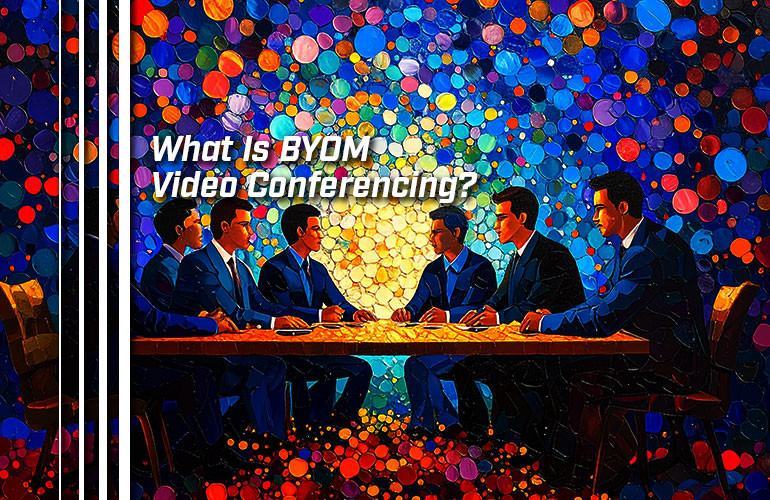With the recent news of Skype’s final shuttering, it’s worth considering just how far video communications has come in the past two decades. Think about how many video call options your business has now.
It used to be that you would set up a video conferencing system with devices that were locked into being used with one vendor.
Now, there are dozens of options. Which is awesome. But it comes with problems of its own. Which platform do you use? Do you have to use one platform exclusively?
Skype’s successor from its own company is Microsoft Teams. Skype’s successor in being the verb we call use as shorthand for a video call is Zoom.
But there are many more platforms than Microsoft Teams and Zoom out there.
Truth is, you likely don’t want to use one platform exclusively. Different preferences, different features, different clients, different pricing — whatever the reason.
That’s where BYOM comes into the conversation: you have the devices and bring your meeting platform to the devices — whatever the platform.
In this blog, we clearly explain what BYOM video conferencing is and what its advantages are for your business.
Let’s get into it!

BYOM Means Bring Your Own Meeting
BYOB means when you bring a six-pack to a picnic. Wait. That’s not what we’re talking about.
With business communications, there are two BYO-terms to know about: BYOD and BYOM.
BYOD means Bring Your Own Device. BYOM means Bring Your Own Meeting.
The two terms essentially mean the same thing: you have devices that work across all the communications platforms that your business uses. But the two terms come at the concept from different directions.
With BYOD, you focus on the devices. With BYOM, you focus on the platform. And that difference is meaningful.
Focusing on the meeting platform puts the emphasis on you and your business. Thinking about BYOM video conferencing is thinking about what works best for you.
The goal is to invest in BYOM video conferencing equipment that can be used by everyone for whatever platform they need to use.
It improves the agility of your business to establish a BYOM video conferencing system in the office. You’re able to shift from platform to platform based on the specifics of the moment without being forced down one pathway every time.
It’s especially useful for integrating hybrid workers and remote workers, because they’re more likely to use different services than home office.
What kinds of BYOM video conferencing devices are there?
For video conferencing, the most important device is the USB Video Bar. A video bar combines camera, speaker, and microphone into one device. A USB video bar is simply one that connects to a laptop or other computer via USB.
Connecting via USB allows you to select it as an audio/video peripheral in the virtual meeting application, just like you would select a headset or a webcam. Every platform we’re aware of supports USB peripherals. The U in USB stands for Universal, after all. (SB stands for Serial Bus, if you were curious.)
Video bars provide professional-level performance on group calls, far beyond what you’ll get with a webcam and a laptop microphone. They’re so important to modern communications that our experts wrote a whole guide about them for you: Video Bar Buyer’s Guide.

Set up a dedicated BYOM meeting room with a USB video bar. Here’s what can happen:
The marketing manager brings his laptop into the room for a Microsoft Teams meeting between his department and the engineering department, who are at a separate campus. He’ll run the application on his computer, connect via USB, and bring his own meeting to the conference room. Everyone can discuss the new product about to be launched. The marketers can make the new features pop even better in the ad campaign.
After that meeting is over, the technical writing team needs to meet with remote graphic designers for a quick Zoom call to make sure everyone’s on the same page. The user’s manual for the new product needs to match the updated brand identity your business has just established. The writing lead brings her laptop, plugs in, and runs Zoom flawlessly on the same equipment as the marketing department used.
Then the coding team needs to meet with a series of localization experts around the world to finalize the translations of all the features. The team has to cycle through a variety of services to match what the experts in other countries use. But they’re able to maintain professional standards across all the meetings, because of your foresight in building a BYOM system.
This is the advantage of BYOM: professional collaboration without worrying about compatibility.
Of course, there are more BYOM devices than just BYOM video bars.
By this point, we’ve talked about the difference between BYOM and BYOD a lot. But it’s time for us to admit that BYOD devices and BYOM devices are the same thing. (The tech world coming up with multiple terms for the same things — who could believe it?)
We go in depth on the variety of BYOD devices in a recent blog, “What Are BYOD Devices for Video Conferencing?” The trustworthy information in that blog about professional BYOM solutions is waiting for you.
If you’d like more information about video conferencing equipment more generally, check out our expert, up-to-date Video Conferencing Buyer’s Guide.

